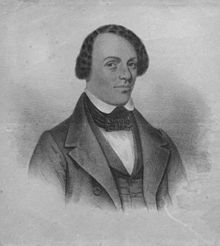George Latimer (escaped slave)
| George Latimer | |
|---|---|

Lithograph by Thayer & Co. (Boston, Mass.)
|
|
| Born |
July 4, 1819 Norfolk, Virginia, U.S. |
| Died | May 29, 1896 Lynn, Massachusetts, U.S. |
| Spouse(s) | Rebecca Latimer, Charlotte (Williams) Saunders, Mary (Turner) Williams |
| Children | George W. Latimer, William H. Latimer, Margaret Ann Latimer Hawley, and Lewis Howard Latimer |
| Parent(s) | Mitchell Latimer and Margaret Olmsted |
George Latimer (July 4, 1819 – May 29, 1896) was an escaped slave whose case became a major political issue in Massachusetts.
George W. Latimer was born in Norfolk, Virginia. His father, Mitchell Latimer, was a white man and his mother, Margaret Olmsted, a slave belonging to his uncle Edward A. Latimer. In the early part of his life he was owned by a man named Edward Mallery, for whom he worked as a domestic servant until the age of sixteen. After that time, his labor was hired out and he primarily worked driving a dray and as a shopkeeper. On two separate occasions he spent time in prison as a result of the debts of his master. He was eventually sold to James B. Gray. Gray was a shop owner whose store Latimer manned. He abused Latimer and it is thought that this abuse precipitated Latimer's flight to Boston.
On October 4, 1842, Latimer and his wife, Rebecca, who was pregnant at the time, ran away. The pair hid beneath the deck of a northbound ship that took them to Baltimore. From there they traveled to Philadelphia, with Rebecca posing as a servant to her lighter-skinned husband. At last, they made their way to Boston, arriving on either October 7 or 8th. James Gray offered a reward of $25 if Latimer was captured in Virginia and $50 plus expenses if he was captured outside Virginia. On the day George Latimer and Rebecca arrived in Boston, Latimer was recognized by a man named William R. Carpenter, a former employee of James Gray, who contacted Gray. On October 20, Latimer was arrested. The initial charge was larceny. Latimer was brought before Justice Joseph Story, who ordered that he be held.
After Latimer’s arrest word spread through the black community and a group led by Henry G. Tracy attempted to rescue him. They were unsuccessful. Latimer’s lawyer, Samuel Edmund Sewall, then sought a writ of personal replevin from Massachusetts Chief Justice Lemuel Shaw, who was known to have strong anti-slavery views. Sewell argued that Latimer should have the right to have his identity determined by a jury. This attempt at freeing Latimer, however, also failed, as Shaw denied the writ. According to the abolitionist paper the Liberator, Shaw said that it was a federal matter and the Constitution and the laws of Congress “were to be obeyed, however disagreeable to our natural sympathies or views of duty.”
Latimer’s arrest resulted in an uproar so great that “Boston was, without a doubt, the most potentially violent city in America.” The case brought about an immense public response in the state of Massachusetts. Latimer’s counsel, Sewell, chaired a meeting at Faneuil Hall where attendees not only vowed resistance to slave-catching but also voted for disunion. Additional meetings were held throughout the state, called "Latimer Meetings." These meetings included both black and white abolitionists.
...
Wikipedia
